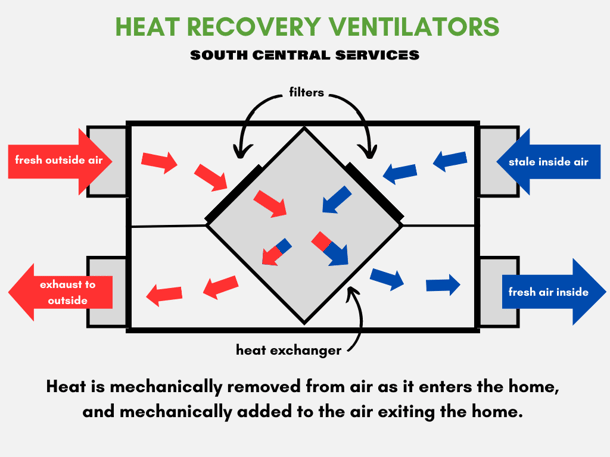HRV Demystified: Everything You Should Know
The All-Inclusive Overview to the Uses of Heat Recovery Ventilation in Modern Structures
Heat Recovery Ventilation (HRV) systems represent a considerable improvement in building technology (HRV Heat Recovery Ventilation). They offer a method for trading stale interior air with fresh outside air while minimizing power loss. This approach not just enhances interior air quality yet also adds to energy performance in both property and commercial structures. Understanding the numerous applications and benefits of HRV can disclose its crucial duty in modern style and sustainability efforts. The effects of this technology are worth discovering additionally
Recognizing Heat Recovery Ventilation Systems

Although several modern buildings prioritize energy performance, understanding heat healing air flow (HRV) systems is vital for maximizing interior air quality and reducing energy usage. HRV systems function by moving heat from stale interior air to inbound fresh air, effectively maintaining comfy interior temperature levels while reducing energy loss. These systems contain a warmth exchanger, fans, and ductwork that promote the flow of air. During winter months, HRV devices capture and recycle heat from the outbound air, while in summertime, they can aid cool down incoming air. By continually exchanging air, HRV systems likewise reduce humidity and the focus of indoor toxins. Proper setup and upkeep of HRV systems are necessary for their performance and performance in improving general structure performance and convenience.
Advantages of Heat Recovery Ventilation
Heat recovery ventilation systems offer numerous advantages that boost both power effectiveness and indoor air high quality in modern buildings. By capturing and reusing power from exhaust air, these systems greatly lower heating and cooling expenses, resulting in reduced energy consumption. They keep a consistent flow of fresh outside air, reducing the threat of indoor air pollutants and allergens. This constant exchange helps regulate moisture levels, stopping mold development and making certain a healthier living setting. Furthermore, HRV systems add to sustainability goals by lowering general carbon impacts. Their capability to maximize ventilation without giving up thermal comfort makes them a beneficial addition to contemporary structure design, promoting both financial and ecological advantages.
Applications of HRV in Residential Structures
As house owners significantly prioritize power performance and interior air quality, the applications of warm healing air flow (HRV) systems in property buildings have come to be more widespread. HRV systems are particularly beneficial in tightly secured homes, where maintaining fresh air blood circulation is vital for protecting against moisture accumulation and interior contaminants. They successfully move warmth from outbound stale air to incoming fresh air, decreasing power prices related to cooling and heating. Additionally, HRVs can enhance comfort levels by controling moisture and temperature. They are also versatile for various domestic styles, including single-family homes and multi-unit structures. On the whole, incorporating HRV systems sustains lasting living practices while ensuring a healthier interior atmosphere for occupants.
HRV in Commercial and Commercial Setups
In commercial and commercial setups, the execution of warmth recuperation ventilation (HRV) systems has actually ended up being significantly crucial for optimizing power performance and keeping air high quality. These systems effectively move warm from exhaust air to inbound fresh air, minimizing the requirement for extra heating or air conditioning. This not just lowers power expenses however also adds to sustainability initiatives. Industries such as production, warehousing, and office complex benefit substantially from HRV systems, as they aid control temperature and moisture levels, guaranteeing a comfy and effective atmosphere. Furthermore, HRV systems help in getting rid of contaminants and excess wetness, boosting indoor air high quality. As guidelines around air top quality end up being more stringent, the adoption of HRV modern Read Full Article technology is likely to expand, making it an important part of modern business and industrial facilities.
Future Trends in Heat Recovery Ventilation Innovation

Regularly Asked Concerns
Just How Does Heat Recovery Ventilation Influence Indoor Air High Quality?
Heat recovery ventilation substantially enhances interior air high quality by constantly trading stagnant interior air with fresh outside air while recouping energy. This process reduces toxins, maintains excellent moisture degrees, and guarantees a healthier atmosphere for passengers.
Can HRV Systems Be Installed in Existing Structures?
HRV systems can certainly be installed in existing structures. Retrofitting may require alterations to ductwork and ventilation layouts, yet it substantially boosts energy effectiveness and interior air top quality, making it a viable choice for older structures.
What Upkeep Is Required for HRV Solutions?

Are There Particular Climates Where HRV Is A Lot More Effective?
Heat recovery ventilation systems are specifically effective in climates with substantial temperature distinctions in between seasons. These systems maximize energy performance by recuperating warm from exhaust air, making them excellent for both cold and moderately warm atmospheres.
Just How Do HRV Systems Affect Power Costs?
